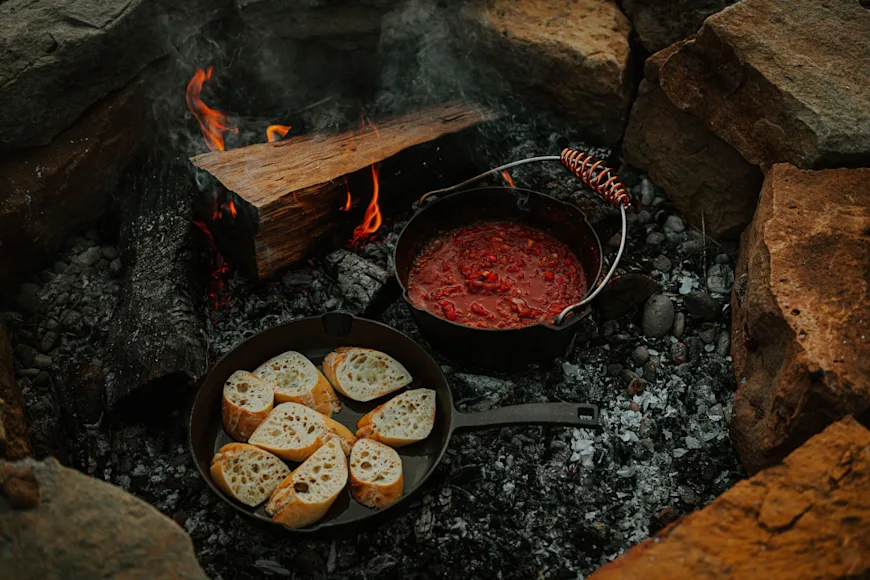_We may earn revenue from the products available on this page and participate in affiliate programs. Learn more ›
_
Best Overall

Barebones Polished Cast Iron Dutch Oven
Best Enameled
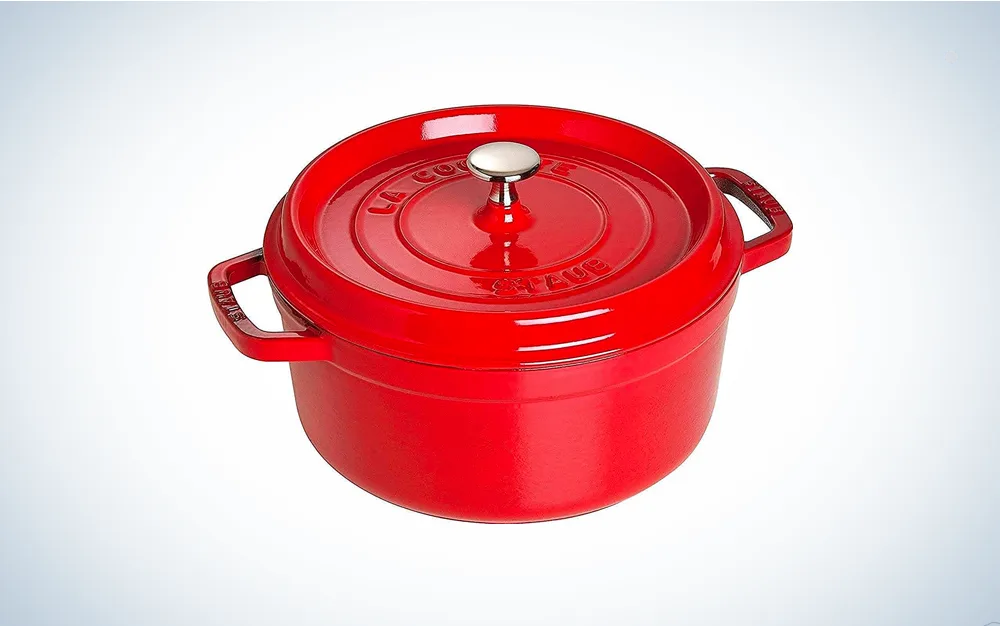
Staub Round Cocotte
Best Budget
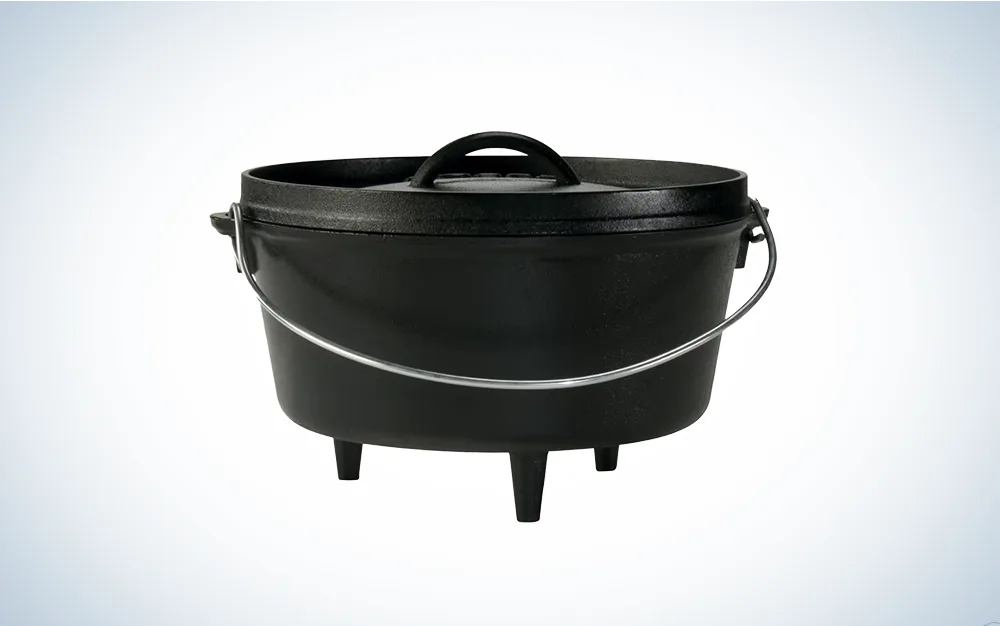
Lodge Cast Iron Dutch Oven
Despite our modern convenience, mankind retains a primal urge to grill meat over a fire. And when it comes to campfire cooking, the Dutch oven might be the perfect tool for the job. Our modern version of the Dutch oven can be traced back to 17th century Netherlands where the practice of making pot from cast irons was popularized. And while design and global commerce have certainly changed since the mid-1600s, the basic tenets of a good Dutch oven haven’t—made from cast iron, designed to cook over the fire, and sturdy enough to last a lifetime of use and abuse.
Today most of us spend more time in air-conditioned kitchens than over open fires. But part of the beauty of camping is coming back to an age of slowness and connection, breathing in fresh air, and cooking over a camp stove or open fire. And when it comes to choosing a cookware vessel, the Dutch oven stands alone. But how do you know which one to buy? We narrowed down our favorite models into categories to help point you in the right direction. Here are our favorite Dutch ovens for camping.
Best Overall: Barebones Polished Cast Iron Dutch Oven
Best for the Pro Camp Chef: Snow Peak Cast Iron Dutch Oven
Best Enameled: Staub Round Cocotte
Best Aluminum: Snowpeak Caldero
Best Backpacking: Banks Fry Bake Expedition Set
Best Budget: Lodge Cast Iron Dutch Oven
How We Picked the Best Dutch Ovens for Camping
I’m a dedicated, and obsessed, camp chef. For me, food serves as the crux of a camping experience, and having suffered through enough mornings of cold, lumpy oatmeal, I’ve made it a personal quest to never again eat poorly while sleeping under the stars. These Dutch ovens have been tested in the field and at home. Combining past field experiences in Alaska’s islands and Flagstaff’s high desert with head-to-head testing in local campsites. Each of the following selections has been put through the wringer and earned a well-deserved spot on this list. I broke my selections down into categories to help fine-tune your next Dutch oven purchase.
Best Dutch Ovens for Camping: Reviews and Recommendations
Best Overall: Barebones Polished Cast Iron Dutch Oven
Best Overall

Specs
Materials: HT150 Iron, copper plated No. 70 spring wire (4mm gauge), 100 percent sunflower oil
Dimensions: 11.5 inches x 11.5 inches x 6.5 inches (12 inch handle)
Weight: 12.8 pounds
Pros
Higher steel content makes it comparably lightweight to other cast iron products
Polished cast iron allows for even heat retention and good searing
Copper-wrapped handle disperses heat for easy maneuvering over an open fire
Legs allow for coal management under the pot
Lid serves as an extra cooking surface
Cons
Lid ring can be difficult to catch when cooking over a fire
Tapered build can make baking small amounts of goods finicky
The Barebones brand focuses on creating products that connect people to food, nature, and “the primal pull of the fire.” And while that might be some copywriter’s magic touch, the brand really does focus on outdoor gear that harkens back to cooking over an open flame. So it’s not surprising that they have a robust cast iron offering. Their dedication to the craft shows with their Polished Cast Iron 4 quart Dutch oven, full of small details that make cooking over an open fire easier and better.
This polished cast iron contains a higher amount of steel than others on this list, which allows for greater temperature variance and lighter design. The legs on the bottom are the perfect height for controlling heat under the pot via coals, but spaced out enough so the oven can still rest on a campfire grate. The brass spiraled wrapped handle disperses heat so you can move and adjust the Dutch oven without fear of burning (we still recommend wearing heatproof gloves like these from Ooni
).
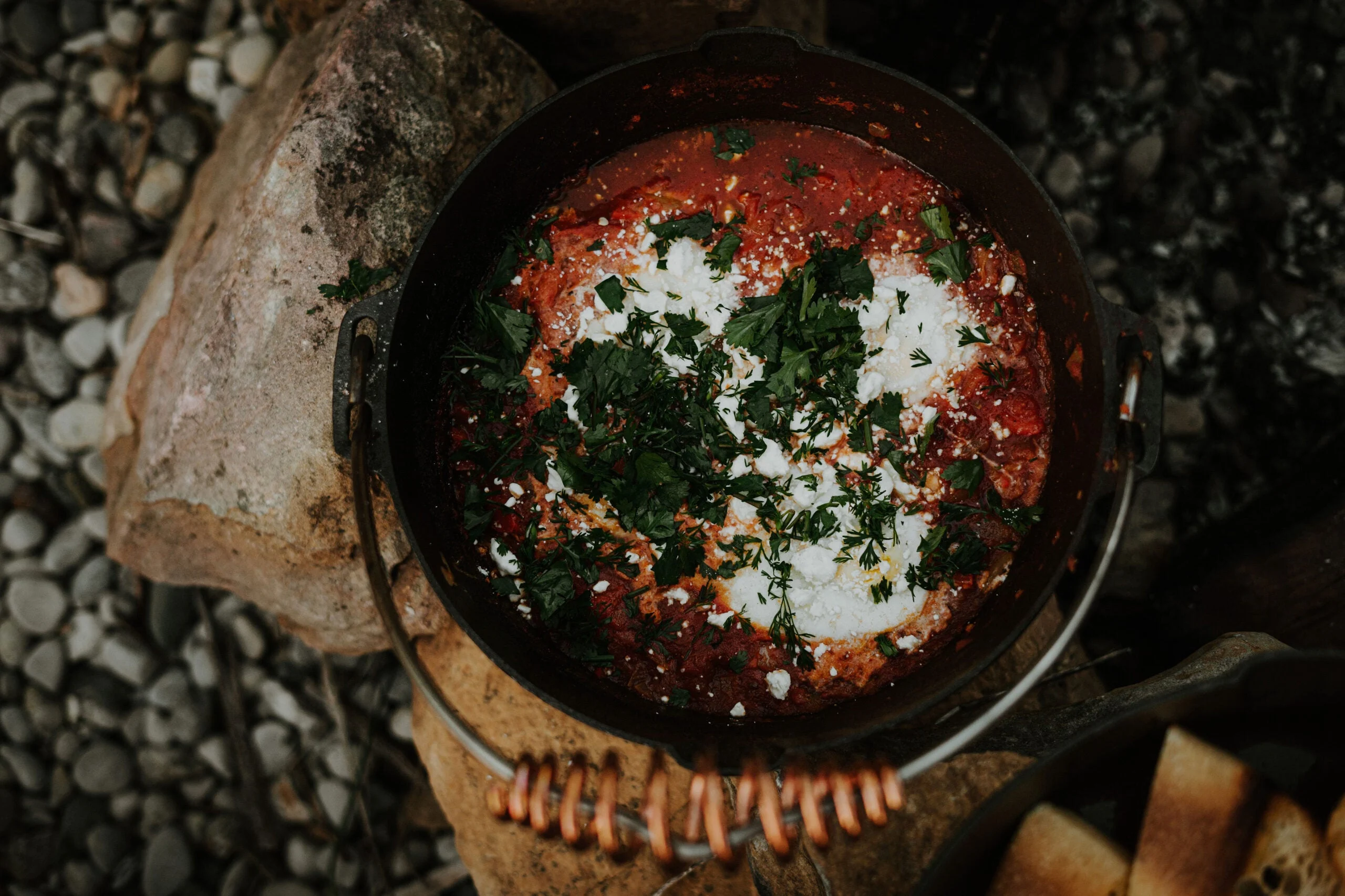
The Barebones Polished Cast Iron is the best we tested. Barebones
But it’s not perfect: the copper ring on the lid can be finicky to get ahold of, especially when over the fire. And while it’s plenty capable of baking, the tapered sides and depth of the pot make it more suited for cooking stews or roasting meats. But for an overall performance across the board, Barebones takes the cake—and bakes it too.
Best for the Pro Camp Chef: Snow Peak Cast Dutch Iron Oven
Best for the Pro Camp Chef
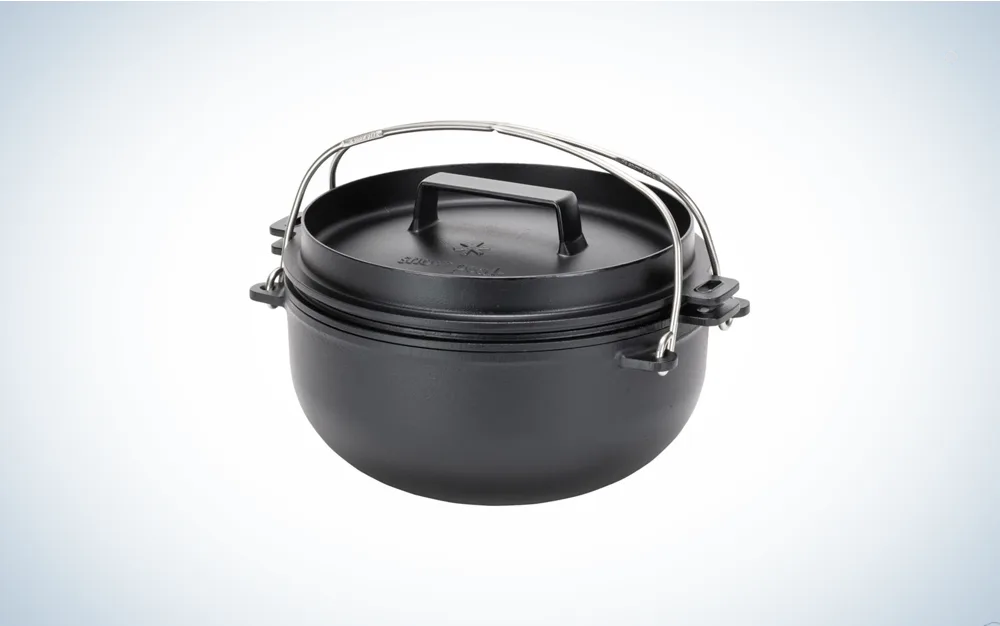
Specs
Materials: Made-in-Japan cast iron
Depth: 10.6 inches
Capacity: 1.4 gallons
Weight: 16.8 pounds
Pros
Solid, full cast iron construction
Optimized cooking dimensions
Nesting system (including a skillet) stores well when not in use
Cons
Flat bottom, instead of legs, can make coal management difficult
Requires accessories to use to the fullest capacity
Expensive
Snowpeak wasn’t messing around when they designed their 26cm Dutch oven. Made of polished cast iron in the Japanese nesting style (including a cast iron skillet), this Dutch oven is both beautiful to cook in and look at. It is also the most expensive Dutch oven on the list, but the quality craftsmanship, materials, and thoughtful aesthetics justify the steep price tag. To use it best, you should also pick up Snow Peak’s Lifter Pro
, which helps lift and control the lid. We found that to really unlock Snowpeak’s performance, their branded accessories were necessary.
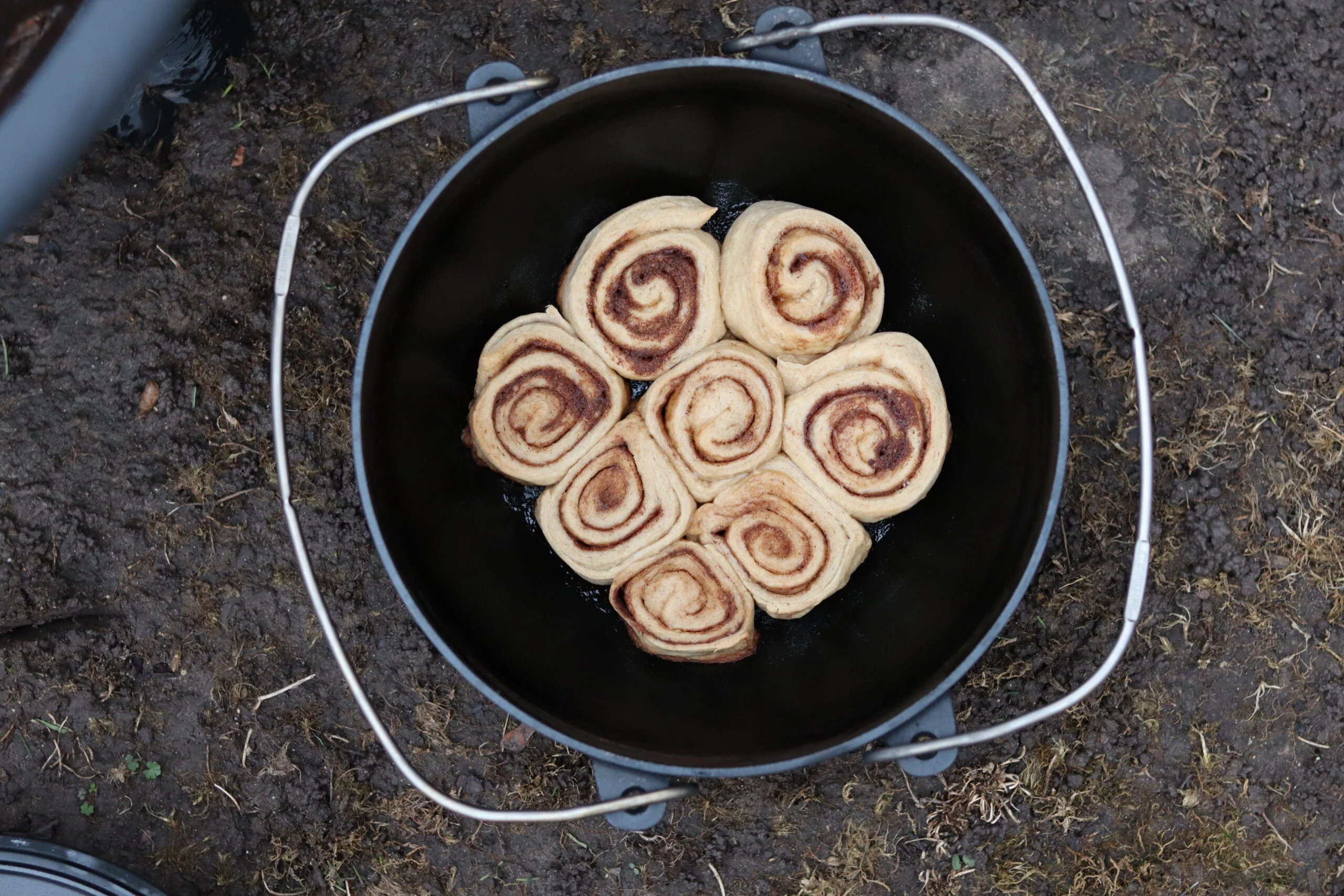
The author uses the Snowpeak Cast Iron Oven 26cm to bake cinnabons. Matt Medendorp
For the casual weekend camper, this may not be worth the investment. But for the cast iron obsessive, this is arguably the best camping Dutch oven on the market. And if you’re looking to channel your campfire cooking in the backyard, their Takibi grill
means you don’t have to head to your local overnight spot to cook over coals.
Best Enameled: Staub Round Cocotte
Best Enameled

Specs
Materials: Enameled cast iron
Dimensions: 11.83 inches x 9.45 inches
Weight: 10.46 pounds
Heat resistance: 500.00 F
Cold resistance: -4.00 F
Pros
Lid design retains moisture and aromas for cooking soups and stews
Enameled surface allows easy clean-up
Dual functionality in home and camp kitchen
Excellent for bread baking
Cons
Can’t place directly on campfire coals
Expensive
Yes, you can take your enameled Dutch oven camping, despite what you might read online. Enameled Dutch ovens have different rules of engagement than their non-coated cousins, but don’t let that stop you from bringing it camping. For every drawback—a lower heat index, limited campfire cooking options, the worry of chipping the enamel—there’s an equal benefit…superior heat distribution, ease of cleaning, and no danger of rusting.
Stuab is your best bet for an enameled Dutch oven that can traverse frontcountry and backcountry kitchens. When I’m cooking any one-pot meal at home—pastas, soups, hearty rice dishes—I reach for this Staub cocotte. And in camp, one-pot meals are king. Staub’s 4 quart Cocotte can cook enough food for a group, but its excellent heat retention means that smaller meals won’t grow cold. It’ll fit on your two-burner Stanley, but can also be transferred to the campfire grate for a long slow simmer for chilis, cornbreads, or braising meat. And the non-stick enamel will make clean-up a dream.
Best Aluminum: Snow Peak Caldero
Best Aluminum
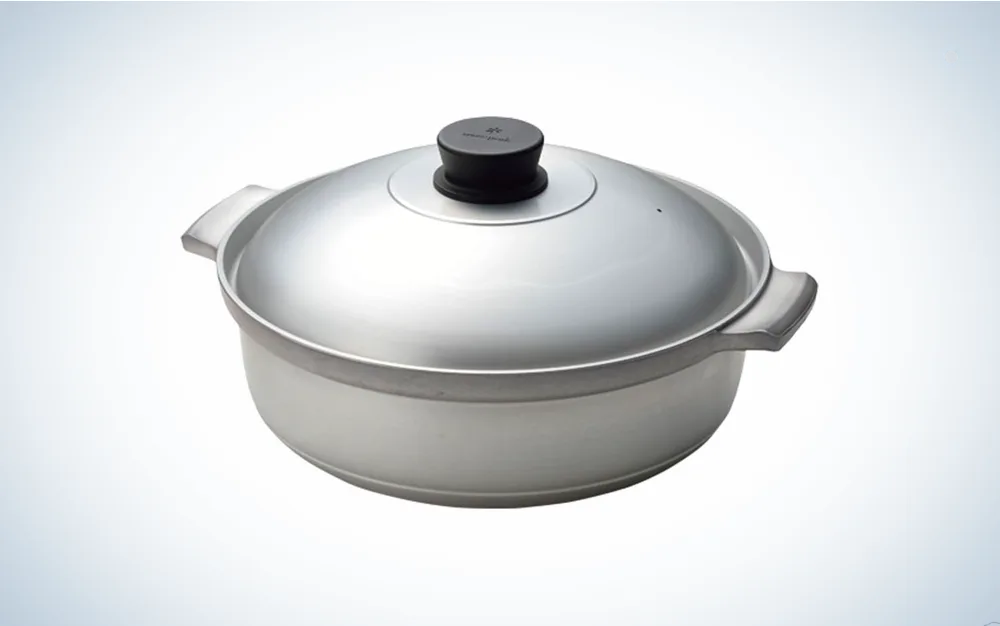
Specs
Materials: Cast aluminum, Made-in-Japan
Dimensions: 12.2 inches x 14.4 inches x 7.1 inches
Weight: 4.18 pounds
Capacity: 6.1 liters
Pros
Lightweight
Campsite and home kitchen capable
Easy to clean
Cons
Less durable than cast iron
Lower temperature rating than cast iron
Alright let’s get this out of the way: yes this is technically a Caldero, not a Dutch oven, but hear me out. While it may have a different linguistic root and/or nomenclature, its usage is similar to the Dutch oven and deserves a space in your camp cooking rotation. There are trade-offs to using something made from cast aluminum rather than cast iron: cast aluminum has less even heat retention, leading to more hot spots, and is significantly less durable than cast iron.
But cast aluminum is wildly lighter than cast iron and far more versatile than your normal stock pot, meaning it’s a great halfway point for any adventure where you’d rather not lug a heavy duty kettlebell of a cooking implement along like canoe trips or horsepacking.
Snowpeak’s Caldero applies their signature attention to design to the whole construction. Ideal for multi-use, one-pot meals, it works well on the camp stove or on the fire grate of a campfire (though expect some discoloration from smoke). We wouldn’t recommend placing it on the coals, or for placing anything hot on the lid next to the rubber handle, but other than those basic steps you don’t have to baby it. The cast aluminum also requires less delicate care than cast iron.
Best Backpacking: Banks Fry Bake Expedition Set
Best Backpacking
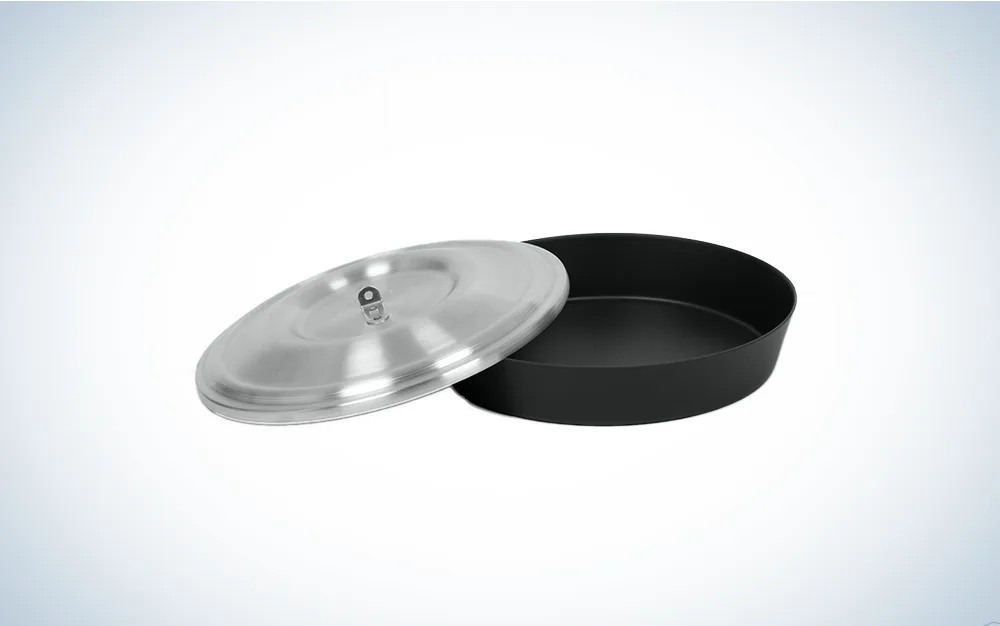
Specs
Materials:
Pan: .090 inches, 60-61 “O” temper aluminum, then given Uniform Anodic Coating of .002 inches of clear hard coat
Lid: .062 inches 1100 “O” temper aluminum
Dimensions: 10 1/2 inch diameter x 2 inch depth
Capacity: Holds 10 cups (2.4 liters) when full
Weight: 29 ounces
Pros
Incredibly lightweight
Easy to clean
While not technically non stick, the anodized aluminum functions almost as a non-stick surface
Cons
Smallest capacity on this list
Lower temperature rating than cast iron
In general, backpacking and the Dutch oven don’t mix well. But Fry Bake solved that problem when they created their Expedition Set from an anodized aluminum that is lightweight, practically nonstick, requires little-to-no maintenance, and is fire safe. The lid allows you to build a small twiggy fire on top, resulting in the same effect as layers of coals on a cast iron Dutch oven’s lid and results in near perfect backcountry cinnamon rolls every time.
Need more convincing? Each Fry-Bake is made in the USA and is the unofficial pan of the National Outdoor Leadership School (NOLS), whose gearheads outfit practically every student expedition with a Fry-Bake for everything from sauteeing freshly caught fish to baking bread from scratch on a Whisperlite’s pulse setting.
Best Budget: Lodge Cast Iron Dutch Oven
Best Budget

Specs
Materials: 10 inch diameter, 5 inch depth
Capacity: 5 quarts
Weight: 13.49 pounds
Pros
Best cost to functionality ratio on this list
Made in USA
Cons
Raw rather than polished cast iron, which cooks slightly less evenly and takes longer to season properly
Less features than other on this list
Lodge is an American classic for a reason. All their cast iron products are made in the USA, crafted in the brand’s South Pittsburg, TN foundries. And this isn’t their first rodeo, Lodge has churned out quality cast iron since 1896. The Deep Camp version comes with all the necessary details for campfire cooking: legs to elevate the oven’s bottom from the coals, raised lip on the lid, and a handle for lifting. It’s made from a raw cast iron, which is slightly more porous than the polished versions on this list. But that’s what allows Lodge to sell this oven for a sub $60 price point, and for that price, it’s a steal. The Deep Camp has 80 percent of the performance features you see in more expensive options, but for far less cost, making it ideal for hunting or fishing camp.
Note: if you’re looking for a Dutch Oven for baking purposes only, Lodge makes shallower options that are ideal for bread, cakes, and other gluteny goods. But you can bake in the Deep Camp Iron Oven, which is our choice for cooking whatever your heart (or stomach) may desire.
What to Consider When Choosing a Dutch Oven for Camping
A successful camping meal can take a lot of planning and consideration. So make sure to think of the following factors before purchasing a Dutch oven for your next trip.
Group Size
Many of these brands — Lodge in particular — make Dutch ovens in a wide variety of sizes. While we’ve recommended products that are the most versatile, you may need to size up, or down, for your group size. No matter how good your Staub Cocotte baked bread might be, one loaf isn’t going to feed twenty people.
Meal Time
Dutch ovens excel in a certain kind of cooking: low and slow. Especially when cooking over a campfire, optimal results take a combination of carefully controlled coals and time. And while, in a pinch, you can always use them as a deep bottomed skillet for sauteing or frying, it’s best to plan ahead for hours of cooking time, instead of minutes.
Frequency of Use
Cast iron can be an investment, in both labor and price. Though that requires a little more maintenance than your typical pots and pans, a well seasoned and cared for Dutch oven will literally last you a lifetime—which can’t be said for many products today. However, if you’re a more casual camper or inclined to use paper plates at home instead of washing dishes, it might not be the right choice for you. Think about going the enameled or aluminum route. While the performance benefits aren’t 1:1, the ease of cleanup and lack of maintenance might be ideal for you.
FAQs
**Q: What is the difference between a Dutch oven and a camping Dutch oven?**
Usually a camping specific Dutch oven is designed for camping over coals and open fire, while other Dutch ovens are designed with a home kitchen in mind. Look for details like [bottoms legs], a lid with a raised lip for holding coals, and a wire handle that allows you to move the oven around the fire without picking up the sides.
Q: Can you use an enamel-coated Dutch oven over a campfire?
Yes, but with some caveats. Enamel-coated Dutch ovens are a workhouse of practicality, but that enameled coating lowers the overall heat capacity of the vessel. We don’t recommend using an enamel cast iron over open flames, or putting it directly in the campfire. However, it’s entirely safe to use an enameled Dutch oven over coals with a grate—like the ones more campgrounds have for grilling. And if you have a colored enamel, the heat and smoke may cause some discoloration, so we recommend buying a black colorway for camping specifics.
Q: How do you clean a Dutch oven when camping?
That depends on the material it’s made from. For enameled and cast aluminum, a simple rinse with warm water and dish soap and scrubbing with a sponge or kitchen brush will work. For cast iron dutch ovens, follow the same conventions for cleaning a cast iron skillet. Wash with warm water, and, if you want, soap (yes, I know, but modern soap is made without the seasoning-stripping lye of traditional soaps and is safe to use on cast irons). A chainmail scrubber like this one
from Barebones can help with baked-on grit. The most important thing is to dry completely after washing (paper towels aren’t enough, you’re going to want to put it back over the fire of a camp stove to evaporate any contained water). Then rub with a coating of neutral oil, like sunflower or canola.
Best Dutch Ovens for Camping: Final Thoughts
Best Overall: Barebones Polished Cast Iron Dutch Oven
Best for the Pro Camp Chef: Snow Peak Cast Iron Oven
Best Enameled: Staub Round Cocotte
Best Aluminum: Snowpeak Caldero
Best Backpacking: Banks Fry Bake Expedition Set
Best Budget: Lodge Cast Iron Dutch Oven
While every Dutch oven (or Dutch-oven-esque pot) on this list will serve you well at the campsite, Barbones offers the best features to value ratio. It performs well in a variety of circumstances, is purpose built with campfire cooking features, and contains a subtle blend of steel to reduce overall weight. That’s why if you could only to choose one Dutch oven for a lifetime of camping adventures, Barebones is our pick.
Why Trust Us
For more than 125 years, Field & Stream has been providing readers with honest and authentic coverage of outdoor gear. Our writers and editors eat, sleep, and breathe the outdoors, and that passion comes through in our product reviews. You can count on F&S to keep you up to date on the best new gear. And when we write about a product—whether it’s a bass lure or a backpack—we cover the good and the bad, so you know exactly what to expect before you decide to make a purchase.

